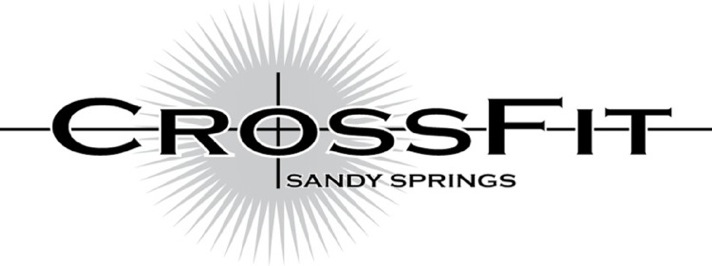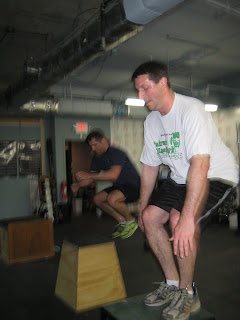"CrossFit doesn't look like your workout. No, it doesn't.
There are no '3 Sets of 8.' Not a single 'triceps kickback' to be found. And while we have lots of novel exercises to 'work your core' and 'improve your stability,' we prefer to teach you to move better in your own skin than stand you on a blue-pimple novelty and watch you quiver.
We make big claims: that we create an elite level of fitness. That we get you places you've never, ever, ever been before. That their workout is our warmup. To back those claims up, we have to do movements that are efficient, challenging, and get you far more bang for your buck than a selectorized machine ever could.
A clean and jerk, for instance: once a staple of the workout crowd, and a fundamental lift for improving your grocery-carrying and storage, is banned from nearly every 'fitness club.' For all the wrong reasons, too: it requires coaching, chalk, and the occasional drop of a barbell from overhead. Knowledge plus cleanup plus noise? Not an option if your teenage 'personal trainers' have to learn it all in a two-day course.
But a clean and jerk is a big lift, requiring a lot of energy. From a purely mathematical standpoint, it's four times as challenging as a bench press. If it seems scary, it's only because you haven't seen it around much - or have you? Lifting your bike onto your roof racks - that's a clean and jerk. Storing your Christmas lights on the top shelf - that's a clean and jerk. Doing it in the gym first just makes you break fewer bulbs. And fewer backs.
That's right: contrary, maybe, to what you've been told, this stuff prevents injuries. The strongest, safest backs in the world belong to powerlifters, NOT bed-resters. Knee injuries are typically the result of misuse, imbalanced use (the knee extension machine, anyone?) or non-use. Deadlifts don't hurt your back - given the right chance, they'll save it. Ask around: chiropractors, physiotherapists, and doctors send patients to us. We modify our methods for the injured, yes. But they're on the same road as our competitive CrossFitters, albeit a different starting line.
We choose to exercise in stark boxes. While exercisers from the 1920s,1930s,1940s, and 1950s would feel right at home, the modern machine-indoctrinated fitness pursuer will struggle to comprehend our methods. At least, at first. Slowly, they'll recognize little glimmers of sameness. "Hey, I did that as a kid!" "We do squats at my gym...but we don't go that low." "I've seen this on TV, but I never thought I could do it...."
Our workouts are short, but tough. But you'll want more. After a month, you'll find yourself checking our website on a daily basis, and joke about 'drinking the Kool-Aid.' After three months, you'll start breaking your own personal bests and bringing your friends. We've grown because CrossFit is amazing, not because we have a special limited-time offer on our membership.
Now, there's no denying that for most people, once they've been immersed in CrossFit, they can't ever go back to average. It tattoos you. And once you've offered up your fresh, pink skin to the prick of the needle, its mark is indelible. You can't undo CrossFit; once you've been painted, you can't go back to beige.
There's joy in sweat. There's family in common discomfort. There's a chemical addiction that comes from challenging yourself this way. There's pleasure in learning new stuff every single time you're in the gym. That's what CrossFit is: sweat+community+knowledge. Call it what you like."
If you made it through all that I'd like to hear your thoughts. For those of you drinking the Kool-aid (and I like to think all of you are) : What made you stick with it? Can you pinpoint a specific moment or was it a gradual change?
-Paul Siegel





































